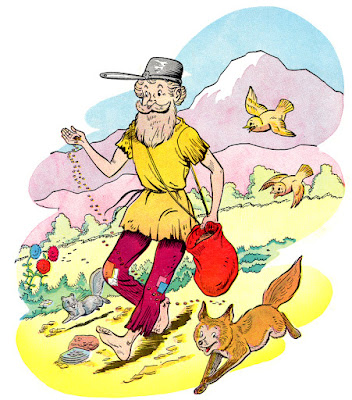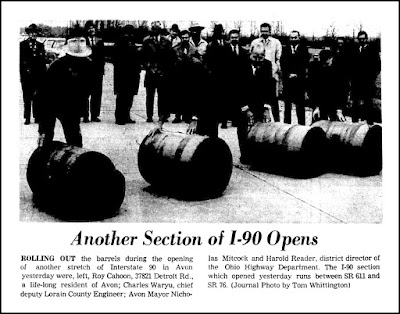Here’s an interesting article written by
Journal Staff Writer Bob Cotleur about Wells Gray, the president of Lorain Creamery. The profile ran in the paper back on November 15, 1970. At the time, the business had just expanded to Avon Lake with the opening of the Old English Parlour on Miller Road.
In the interview, Gray sheds some light on his background as a college football star, and shares his thoughts about the future of the creamery business.
Like many Lorainites, I have many pleasant memories of getting ice cream cones at the walk-up window at the Creamery, as well as enjoying many sit-down treats at both Old English Parlour outlets. My sister worked for the Grays as a waitress at the Parlour in Lorain.
Strangely enough, until I read this article I didn’t realize that the pretty girl with the last name of Gray in my class at Admiral King High School was the daughter of the man who was the president of the Creamery.
****
Wells Gray: From Football to Lorain Creamery
“This clippity-clop has got to stop. You’re drivin’ me nuts in the mornin.’ Deliver the milk but get rid of that silk, That high-stepping’ horse is deplorin’...
– From a factory worker’s pre-dawn complaint, circa 1980 to 1930-plus.
By BOB COTLEUR, Staff Writer
WELLS ORION GRAY, a handsome, rugged, 36-year-old former college football star, is president of Lorain Creamery Inc., a milk and ice cream palace.
Gray and his brother, Paul, 32 and cousin, Dick Gray, 36, are part of the management team that recently spent $300,000 to open an English Cottage-styled, 104-seat old fashioned Ice Cream Parlor in Avon Lake a few weeks ago. Even the spelling is English and old fashioned.
The milkmen employed by the Lorain Creamery home-deliver bread, eggs, laundry soap, glassware, candy and hand lotion, to name a few of the non-milk items stacked inside the milk trucks.
“One of our best sellers,” says Wells Gray, “is chicken pot pie.”
Yet what’s up front... is milk.
And what Wells Gray is... is contrast.
“Wow-wie,” says dark-haired, small and pretty Mrs. Eva Short, manager of the cozy 25-seat ‘parlour’ at the plant site on Oberlin Avenue and 14th Street in Lorain. “Wells Gray is a terrific guy, a hardworking man’s man. But always the same. He always says, “How ya doing’ Ev,’ or he calls me ‘Chief.’”
Mrs. Short, with her wide, friendly smile, sees and likes the outer man.
She knows he won a football scholarship from Lorain High, to the University of Wisconsin and that as a six-foot, 220-pound guard he became the Badger’s captain in 1955 and won honorable mention on the All-American scene. She may even know he was drafted by the Washington Redskins at the same time he was drafted by Uncle Sam.
And Uncle Sam won, of course. She’s got to know that.
BUT SHE MAY NOT know he earned his degree in agriculture with a major in dairy farming which is of itself a contrast, for Lorain Creamery never owned a cow. It buys its basic milk from a Cleveland co-op known as Milk, Inc., even though the raw milk comes from cows in Henrietta, Birmingham, South Amherst, “all around here,” as Wells Gray says.
But she doesn’t know the inner man.
“Sometimes I feel frustrated behind the desk, “ said the Badger guard who played an All-Star game with Sam Huff. He also roomed with Jim Temp, for seven years a defensive end with Green Bay, and, at another time, with Quarterback Jim Haluska (Browns, Chicago Bears). “Sometimes I like to get more involved in the physical things. I feel that I think better when I get out and work.”
Once he even thought of another kind of work. But after a talk with his late dad, it faded away. “Dad pointed out there would always be a need for milk,” Gray said, “and it seems there always was plenty to do around the creamery.”
That’s Wells Gray’s philosophy today and the only contrast between him and his late father was one of age.
But, for the man who turned away from pro - football after military service because of bad knees, still another contrast arrived in life.
His wife, the former Kathleen Mramor of Lorain who had earned her degree in fine arts at Ohio State University and now dabbles in interior decorating, was a part of it. When Kathleen Gray complained that Wells’ pipe was “smelling up the house” and the kids were “after me with those TV commercials about smoking, I gave it up.
“Didn’t smoke much anyhow,” he said, sounding like Blanton Collier after San Diego dunked the Browns.
But Wells is very proud of his wife. “She did the decorating of our Avon Lake ice-cream parlour-restaurant,” he says, “and she works Monday and Friday evenings at T. N. Molas’ furniture store as the interior decorating consultant.”
Wells Gray missed one of the more interesting scenes of business life when, back on June 17, 1931, his father Wellsley D. Gray and his two partners proudly announced the opening of their new $40,000 store on Oberlin and 14th Street. They had been in business since 1923 and this was a great step forward.
IT WAS THE depression. Herbert Hoover was at Marion, Ohio, dedicating a monument when an airplane flew over and drowned him out and making him irate enough to threaten Congressional action against planes flying over crowds. Al Capone was having his troubles that day with federal agents.
But the big story in Lorain was the birth of a new business (Lorain Creamery) during the depression.
Wells Gray missed it all because he wasn’t born until 1933.
“As kids we worked on the horse and wagons (not everything was rubber-tired trucks) before we had drivers’ licenses,” he said of the three partners today.
He said his dad, who suffered a stroke in the summer of 1968 and died the next January, was very easy-going. “He rarely lost his temper and I can’t ever remember him swearing.”
Later on, Wells got his drivers license and then spent some summers spelling the milkmen on vacation. Even today, as late as a few years ago, “when help was hard to get,” he and Paul and Dick got out and handled routes as well as running things in general.
AS THE FOUNDING fathers left the scene, Wells took over operations and production. Cousin Dick handled office and managerial responsibilities and Paul ran the ice cream production and route work. All three are equal shareholders in Lorain Creamery and Wells guesses they made him president “because I was the oldest.” But he isn’t too impressed with it “because we share in all responsibilities.”
Lorain Creamery even today isn’t huge by most standards, but it processes some 40,000 pounds of milk each day, about 3,000 gallons, and covers a home delivery territory in the upper two-thirds of Lorain County (nothing in Oberlin), west to Huron in Erie County and east to Bay Village.
When the new operation in Avon Lake was approved, a new corporation, Parlours Inc., was formed with Paul Gray as president.
“We have 33 people with Lorain Creamery,” Wells said, “which includes 20 route drivers. Paul also has 33 people in Avon Lake, 25 of them are waitresses.” (The ice cream parlour also serves light lunches, these chilly days.)
The real success of Lorain Creamery is the firm’s ability to make headway against the tides of the times. When the founders began business in 1923, there were at least seven or eight creameries serving Lorain, Wells said. Today there are four. “Home Dairy, Clovervale, Trotta, which distributes for Oberlin Farms, and ourselves.”
He felt that Dairyman’s Association, large on the scene just a few years ago, had just about ended all their home delivery routes.
“We still have all of ours even though other companies have cut back,” he said. Gray offers a mental image of a mother of a large family lugging six half-gallons of milk home from a Lawsons or Clovervale store.
“We save her handling that weight and also hold down her impulse buying,” he points out while adding a package of cookies to the milk in his mental image. He means this is why he sticks with home delivery.
YET HIS OWN diversification techniques – selling soaps and chicken pot pie – came from the idea that if a driver is going to make home stop twice a week, he might as well sell something.
“In the summer time kids frequently switch to Kool-aid, so the driver ought to at least sell a loaf of bread or a dozen eggs.”
But the items the driver offers, Gray says, come from meetings between his partners, a sales and route manager. The five decide. Then the customer is advised by a sales flyer of what items are new and coming soon. He samples, first.
“Halloween candy went very well and Rose - Milk hand lotion was a big seller. So is laundry compound.” They sell more than a ton a month and pitch it on “no polluting phosphates,” one ultra-modern hard-sell technique that blends with old-fashioned, home-delivered handling.
Even the ice cream parlor is built on sophisticated merchandizing methods, despite maple nuts and butter pecans that are real and not ersatz.
“We thought about it a long time, even before dad and the others retired. They were pretty conservative guys,” Gray said in understatement, “but they build the company well and delivered a quality product that survived.”
WHEN THE SONS got control, Paul researched New England states where old fashioned ice cream parlors made it big. Wells visited a successful operation in Indiana and heard management state the parlor doubled their ice cream business.
“Oh, we thought about stores like Lawsons and knew it was a good outlet for your milk and good for increasing your volume, but we liked the profit picture more on ice cream. And when we spent $20,000 to remodel the front of the Oberlin Avenue plant into a 25-seat parlor everybody that came in told us 'too bad it wasn’t bigger.’”
The decision to go ahead in Avon Lake followed naturally. But the caution conservatism of Bothe Wellsley D. and Wells Gray hasn’t flown out the window. Wells believes with a special consultant on the parlor that “the thing to do is stick with your newest investment and really get it going.
“We’ve got an eye on a site or two in Lorain and we may buy the land. But then we’ll wait five years or so...”
It’ll be interesting to see what his children will think and do a couple of decades from now. The oldest, Wells, 14, is tremendously interested in football today and his father finds some of his shiningest moments in “any successes Wells and any of my kids or wife has.”
The other children are Erin, 12, and James, 4.
As for the kids’ father, he still has one more contrast left in his system. “It is possible,” he says, “that in time milk itself could be a relatively small part of our business although milk is the main reason we go to the customer’s house today. But as the public demands certain products, this is what we’re going to have to sell.”
There is, of course, nothing at all old fashioned about that.
****
Like the bread man and the Charles Chips man, the milk man eventually lost favor with the public, who apparently preferred going to grocery or convenient stores for their dairy products. The Creamery had its own little store in the building on Oberlin Avenue offering milk, donuts, cheese, etc.
According to an article in the Chronicle-Telegram from Feb. 2000, the Lorain Creamery lasted until 1989 when it sold out to Smith Dairy.
Today the building on Oberlin Avenue is still there, triggering happy memories of great ice cream to those who remember.





























































